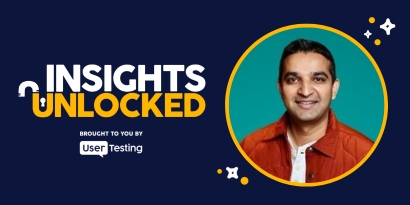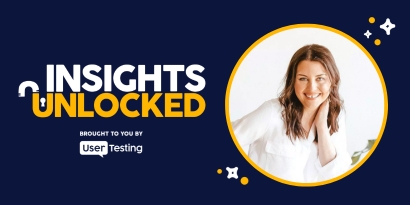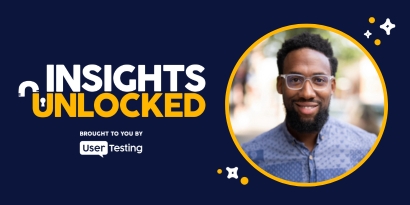
Episode 197 | November 17, 2025
How customer-centric marketing fuels real growth
Learn how Bill Macaitis scaled brands like Slack and Zendesk using customer-centric marketing, capital-efficient growth, and bold B2B brand strategy.
Why customer-centric marketing is the real growth engine for B2B brands
It’s easy to get caught chasing leads and funnel metrics—but what if that’s the wrong race?
In this episode of Insights Unlocked, former Slack, Zendesk, and Salesforce CMO Bill Macaitis joins Nathan Isaacs for a conversation that challenges the way most B2B companies approach growth. From outdated attribution models to safe, copycat branding, Bill breaks down why customer-centric marketing is not just better for your users—it’s smarter for your bottom line.
“Anyone can buy growth. But how do you get it capital efficiently?” Bill asks. “That’s the real question.”
Let’s unpack what that actually looks like for modern marketing and go-to-market (GTM) teams.
The problem with play-it-safe B2B
B2B marketing has a reputation—and not a great one. Most brands sound the same, look the same, and rely on the same funnel-first tactics. But as Bill points out, that approach might check boxes, but it won’t build love.
“Most B2B brands are afraid to stand out,” he says. “They’re overly conservative. And when everyone talks and looks the same, you’re just noise.”
The antidote? A customer-centric marketing strategy that prioritizes real experiences, brand authenticity, and long-term value creation. It’s about marketing with your customer, not just at them.
Building a brand people actually love
Bill didn’t just lead growth at high-profile companies—he helped make them household names. And while many SaaS companies focus heavily on product-led growth or paid acquisition, he believes brand is a key multiplier that’s often overlooked.
“You have to stand out,” he says. “I wanted brands that had a unique editorial tone, a unique visual identity. We used mascots, humor, empathy—consumer playbooks in a B2B world.”
Here’s what sets apart the B2B brands people genuinely enjoy interacting with:
- Human tone and voice: Ditch the jargon. Speak to your customers like people.
- Thoughtful onboarding: Even free plans should provide real value—not just teaser features.
- Helpful content: Think beyond sales enablement. Create resources that solve customer problems, even if they don’t convert right away.
At Zendesk, one of the company’s most popular pieces of content was a guide to interviewing customer support agents. “We didn’t sell hiring software,” Bill explains. “But we knew that was a pain point for our users. So we made something genuinely helpful.”
ON-DEMAND WEBINAR
Tactical (and practical) tips to get fast feedback for better marketing
The key to growth: capital efficiency
For many startups, especially in the AI space, capital has been plentiful. But Bill cautions against confusing cash with clarity.
“If all your growth is bought, that’s not sustainable,” he warns. “You can’t go public unless you’re growing efficiently. You can’t raise another round if you’re underwater.”
That’s why capital-efficient growth is a core tenet of his approach. Rather than throwing money at ads or bloated sales teams, focus on these cost-effective strategies:
- SEO and content marketing
- Community-led growth and word of mouth
- Freemium models that drive product-qualified leads (PQLs)
- Partnerships and co-marketing
In Bill’s words, “If you’ve figured out how to grow without a huge ad budget, then when you do have that money, you’ll know how to use it effectively.”
Customer centricity is more than a buzzword
Customer-centric marketing is easy to say but hard to operationalize—especially in enterprise settings where short-term metrics dominate.
Bill’s turning point came when he realized how frustrating the typical SaaS experience had become.
“The funnel was broken. You go to a site, and everything’s gated. You get harassed by sales. You can’t find support. It’s a terrible experience. And then companies wonder why their NPS is low or why churn is high.”
To flip the script, he recommends aligning teams around customer-centric metrics like:
- Net Promoter Score (NPS)
- Customer Satisfaction (CSAT)
- Daily Active Users (DAUs)
- Time to Value (TTV)
- Net Revenue Retention (NRR)
More importantly, incentivize teams based on these metrics. If your only KPI is MQLs, you’ll optimize for lead volume—not customer value. But when marketing, product, sales, and support all share the same North Star, real alignment becomes possible.
Broken attribution models are holding you back
Another challenge in B2B? Attribution models that oversimplify complex buyer journeys.
“Most tools give credit to the first or last click,” Bill says. “But that’s not how real decisions get made—especially in enterprise deals with 30+ touches.”
Instead, he recommends either:
- Advanced attribution using regression-based AI tools
- Control groups to compare performance across campaigns, channels, or regions
At Slack, for example, the team would run localized brand campaigns in certain cities and compare growth metrics to control regions. This approach gave them deeper insight into how branding and awareness actually moved the needle—beyond what CRM fields or Google Ads dashboards could show.
The AI opportunity (and warning)
As the marketing landscape shifts again with AI, Bill sees massive potential—if used wisely.
“There’s not a single function in marketing that can’t benefit from AI right now,” he says.
Whether it’s generating content drafts, running better A/B tests, or doing attribution modeling, AI can be a true force multiplier. But if you’re just using it to regurgitate generic homepage headlines, you’re missing the point—and probably sounding just like your competitors.
His advice: Use AI to scale your distinct brand voice, not erase it.
- Define your tone, values, and personality
- Train AI tools on your best content
- Use them to transform existing assets and scale new ones—without losing your unique POV
“AI makes it possible to rebrand thousands of assets overnight,” he notes. “Before, that would take months and tons of resources. Now? Days.”
What change actually takes
Implementing a customer-centric strategy or evolving your B2B brand doesn’t just require a new campaign—it takes real organizational change.
“Most of the work I did at those companies was change management,” Bill admits. “You’re convincing people to try a new playbook, which is hard when the old one ‘still works.’”
To succeed, especially in larger organizations, leaders need to:
- Secure C-suite and board-level buy-in
- Align teams on shared customer-first metrics
- Give teams permission to experiment (and occasionally fail)
- Build strong relationships across marketing, product, and sales
- Empower individuals to challenge outdated systems
If you’re in a junior or mid-level role and want to champion these changes, start small. Run a customer-centric campaign and measure NPS or retention uplift. Prove the model works—and build from there.
Final thoughts: shift your mindset, not just your metrics
Marketing playbooks will keep evolving. AI will keep getting smarter. And buyers will keep demanding more human, empathetic experiences.
To stay ahead, B2B marketers need to embrace adaptability and lead with curiosity.
“The playbook should change every year,” Bill says. “You have to go where the eyeballs are. You have to use the tools that give you leverage. And you have to never stop asking: what does our customer really need from us right now?”
That’s the kind of growth you can’t buy—but the kind that lasts.
Episode links:
- Bill Macaitis on LinkedIn
- SaaS CMO Pro website
- SaaS CMO Pro newsletter
- Spike Jonze documentary
- Bill’s YouTube videos
- Nathan Isaacs on LinkedIn
- The importance of customer centricity: This on-demand webinar explores how to align your organisation around customers and build value.
- How to share customer insights throughout your organization: This on-demand webinar focuses on how marketing, product and other teams can distribute customer voice and act on it.
- Customer‑centric product development: build better products fast: This guide practical strategies for integrating customer insight and speed in development.
- Why your organization needs a customer‑centric approach: This blog post outlines why putting the customer first is essential for marketing, brand, growth and sustained success.
GUIDE









